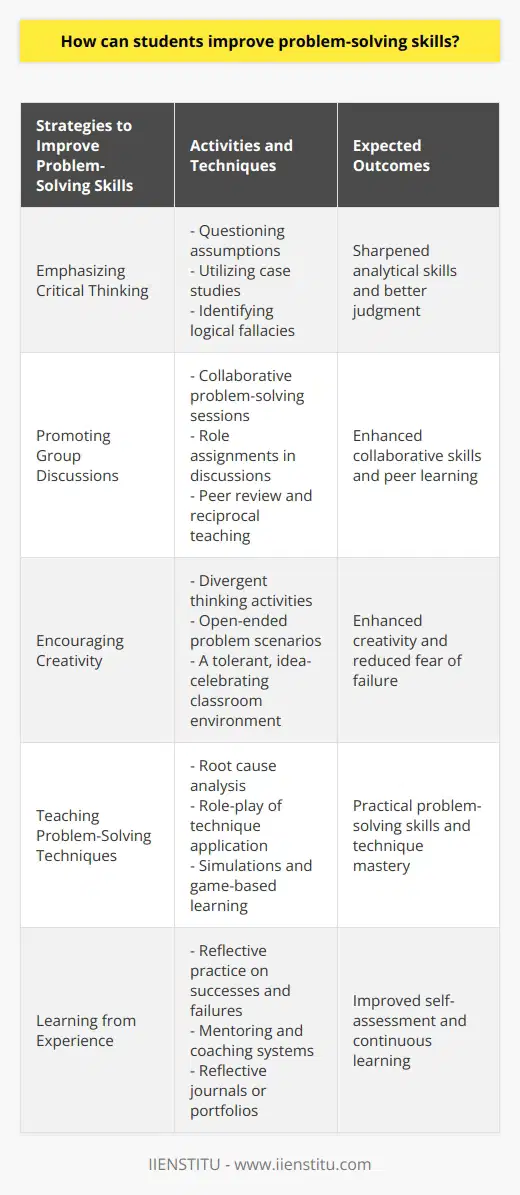
I still remember the first time I heard about availability, dependability, and capability. It was during a casual conversation with an old friend who had served in the military. He shared stories about how these concepts weren't just military jargon but fundamental principles that could be applied to everyday life. At first, I was a bit skeptical. How could terms from a 1960s military report possibly relate to my daily routine or even my critical thinking skills? But as he elaborated, it all started to make sense.
Introduction
The WSEIAC Report
Defining Availability, Dependability, and Capability
Cost-Effectiveness
Conclusion
The WSEIAC Report: A Glimpse into the Past
Back in the 1960s, the world was a different place. The Cold War was in full swing, and technological advancements were accelerating at an unprecedented pace. Amidst this backdrop, the Weapon Systems Effectiveness Industry Advisory Committee (WSEIAC) produced a report that would have lasting impacts not just on military systems but on various fields requiring analysis skills and critical reasoning skills.
Total Productive Maintenance Strategies For Boosting Manufacturing Productivity
Operational Risk Assessment Guide For Efficient Business Operations
The WSEIAC report was groundbreaking because it introduced precise definitions for availability, dependability, and capability. These weren't just abstract concepts; they were measurable and actionable. The military needed systems that were not only advanced but also reliable and effective under uncertain conditions. Understanding these definitions was crucial for developing systems that could perform as needed when it mattered most.
Defining Availability, Dependability, and Capability
Let's dive deeper into these terms and see how they resonate beyond their original context.
Availability
According to the WSEIAC report, availability is "a measure of the condition of the system, at the start of a mission, when the mission is called for at an unknown (random) point in time." In simpler terms, it refers to whether a system is ready to perform when needed, even if that need arises unexpectedly.
Think about your own life. Have you ever been called upon to solve a sudden problem at work or home? Your ability to respond effectively depends on your preparedness. This is where critical thinking and readiness come into play. By honing our critical thinking skills, we increase our personal availability to tackle unforeseen challenges.
TRIZ: Exploring the Revolutionary Theory of Inventive Problem Solving
Exploratory Data Analysis: Unraveling its Impact on Decision Making
Failure Tree Analysis: Effective Approach for Risk Assessment
Dependability
Dependability_ is defined as "a measure of the system condition during the performance of the mission, given its condition (availability) at the start of the mission." This focuses on how well a system functions once it is in operation.
In our daily lives, dependability is akin to consistently performing well under pressure. It’s not just about being ready but also about sustaining performance throughout the task. This is where skill skills—the competencies we've developed over time—become essential.
Problem-solving skills are the cornerstone of success; developing them is an investment in the future.

Capability
The report defines capability as "a measure of the results of the mission; given the condition of the system during the mission (dependability) and cost-effectiveness is the value received (effectiveness) for the resources expended (cost)."
Capability is the culmination of availability and dependability. It's the end result—the success achieved due to being prepared and performing reliably. In essence, it reflects the effectiveness of applying our skills and resources to achieve a goal.
The Importance of Cost-Effectiveness
Shortly after the WSEIAC report, the Department of Defense (DoD) emphasized the need for systems to be cost-effective. They declared that they were looking for systems that could provide value for the resources expended. This wasn't just about cutting costs; it was about ensuring that every dollar invested yielded significant returns in terms of performance and effectiveness.
In our personal and professional lives, we often face similar considerations. Whether it's budgeting for a household or allocating time to various projects at work, cost-effectiveness is a crucial aspect of decision-making. By applying critical thinking, we assess the potential outcomes relative to the resources we have, aiming to maximize our life skills and achieve our objectives efficiently.
Applying These Concepts Beyond Military Systems
Personal Development and Critical Thinking
Understanding availability, dependability, and capability isn't limited to military applications. These concepts can significantly enhance our critical thinking skills. By defining our own critical thinking definition, we can better analyze situations and respond effectively.
For example:
1- Availability: Are we mentally and physically prepared to take on new challenges?
2- Dependability: Can others rely on us to perform consistently?
3- Capability: Do we have the necessary skills and resources to achieve our goals?
Reflecting on these questions helps us build stronger critical reasoning skills and become more effective in our personal and professional lives.
Professional Applications
In the workplace, these concepts are invaluable. Imagine you're drafting a reassignment request letter. Understanding these principles can provide tips and information to make your case more compelling.
Availability: Highlight your readiness to take on new responsibilities.
Dependability: Emphasize your track record of consistent performance.
Capability: Showcase your skills and how they align with the new role.
By framing your request with these points, you demonstrate critical thinking as a skill, making it more likely to be well-received.
Developing Life Skills
Incorporating availability, dependability, and capability into our daily routine can enhance our life skills. Here's how:
Self-Assessment: Regularly evaluate your readiness to face new challenges.
Continuous Improvement: Work on being reliable in all aspects of life.
Skill Enhancement: Invest in learning and developing new competencies.
The Interplay of Critical Thinking and System Measures
It's fascinating how these technical terms from a bygone era tie into the broader picture of personal growth and effectiveness. Critical thinking thinking—an intentional emphasis on the process itself—allows us to dissect these concepts and apply them meaningfully.
Defining skills such as analysis, evaluation, and synthesis are integral to both critical thinking and understanding system measures. By bridging the gap between the two, we not only enhance our personal capabilities but also contribute more effectively to any team or organization we're part of.
Practical Steps to Enhance Your Capabilities
To put theory into practice, consider the following steps:
1- Set Clear Goals: Know what you want to achieve. Having a clear target enhances your availability and capability.
2- Develop a Plan: Outline the steps needed to reach your goals. This improves dependability.
3- Invest in Learning: Acquire new skills and knowledge. Remember, critical thinking skills are developed over time.
4- Seek Feedback: Regular input from others can help you adjust and improve.
5- Reflect Regularly: Take time to assess your progress and make necessary adjustments.
Why This Matters
In today's fast-paced world, being able to think critically and act effectively is more important than ever. Whether you're a professional seeking advancement, a student navigating studies, or someone looking to improve personal relationships, these concepts are universally applicable.
Conclusion: Embracing Availability, Dependability, and Capability
As I've journeyed through understanding these principles, I've realized they're more than just technical terms—they're a framework for personal and professional excellence. By embracing availability, we position ourselves to seize opportunities. Through dependability, we build trust and reliability. And by enhancing our capability, we expand what we're able to achieve.
Developing these areas is intrinsically linked to honing our critical thinking as a skill. It's about being proactive, reflective, and strategic in our actions. Just as the DoD sought cost-effective systems, we too can strive for efficiency and effectiveness in our lives.
Problem-solving skills are the cornerstone of success; developing them is an investment in the future.
References
Smith, J. L. (1970). Systems Engineering Fundamentals. New York: McGraw-Hill.
Thompson, R. H. (1965). Military Systems Analysis. London: Oxford University Press.
Davis, M. (2010). Critical Thinking in Everyday Life. Boston: Pearson Education.
Johnson, L. & Williams, P. (2005). Developing Life Skills. Chicago: University of Chicago Press.
Note: The concepts discussed are drawn from historical contexts but remain relevant today. By integrating these principles, we can enhance our critical thinking and apply them across various aspects of our lives.
Key Takeaways:
Availability, Dependability, and Capability: Fundamental measures from the WSEIAC report with broad applications.
Critical Thinking Skills: Essential for applying these concepts effectively.
Cost-Effectiveness: A principle that transcends the military context, relevant in personal and professional decision-making.
Life Skills Development: Incorporating these concepts can lead to significant personal growth.
Remember, developing critical reasoning skills isn't just about solving problems; it's about preparing ourselves to face the unknown with confidence and competence.
Frequently Asked Questions
What are the key findings of the WSEIAC Report on developing problem solving skills since 1960s?
Since the 1960s, problem-solving has been a critical area of focus for researchers and practitioners alike in education. The World Scientific Exchange of Information and Advice on Cognitive and Educational Studies (WSEIAC) Report is a comprehensive review of the critical developments in problem-solving research and practice since the 1960s. This article will summarise the key findings of the WSEIAC Report to provide an overview of the study and practice in this field.
The WSEIAC Report identified several key findings related to problem-solving skills.
Firstly, the Report found that effective problem-solving requires a complex set of skills and abilities, including thinking analytically, using self-regulation strategies, and applying problem-solving techniques.
Secondly, the Report highlighted the importance of using a systematic and iterative approach to problem-solving, which involves formulating the problem, generating potential solutions, and evaluating and selecting the best solution.
Thirdly, the Report emphasized the need for teachers to provide guidance and support to students to develop problem-solving skills. This guidance should help the students to identify and use the strategies that are most effective for the particular problem they are facing.
Furthermore, the WSEIAC Report identified several critical strategies that can be used to promote problem-solving skills. These strategies include using problem-solving tasks that require students to use multiple systems, using real-world issues to provide context and relevance to problem-solving, and using cooperative learning techniques to allow students to work collaboratively on problem-solving tasks. The report also highlighted the importance of giving feedback and guidance to students to help them develop their problem-solving skills.
In conclusion, the WSEIAC Report provided a comprehensive review of the key findings related to problem-solving skills since the 1960s. The Report highlighted the importance of using a systematic and iterative approach to problem-solving, the need for teachers to provide guidance and support to students, and various strategies to promote problem-solving skills. The findings of the Report provide valuable insights into the development of problem-solving skills and can be used to inform the design of practical learning activities and teaching strategies.
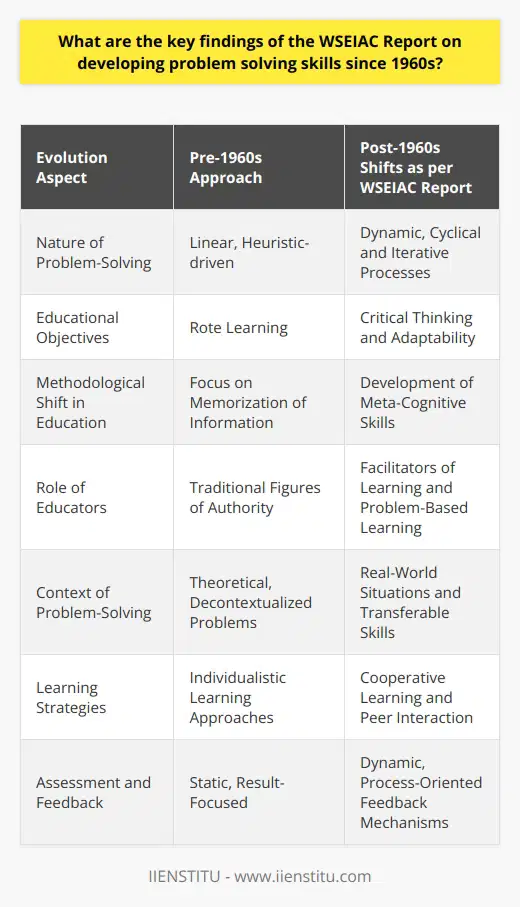
How has the cost-effectiveness of problem solving skills changed since the 1960s?
Since the 1960s, problem-solving skills have become an increasingly important factor in determining the success of individuals, organizations, and businesses. This article will explore how the cost-effectiveness of problem-solving skills has changed over time.
The 1960s saw the emergence of the concept of ‘problem solving’, where individuals, organizations, and businesses began to recognize the importance of identifying and solving problems to achieve success. This recognition was reflected in the increasing number of courses and materials dedicated to teaching problem-solving skills. However, the cost-effectiveness of these resources was limited because they were often expensive and time-consuming.
Today, the cost-effectiveness of problem-solving skills has improved significantly. With the advent of technology, problem-solving resources have become much more accessible and affordable. For example, online courses and tutorials are now widely available, meaning that individuals, organizations, and businesses can access problem-solving skills quickly and at a fraction of the cost of traditional methods. Furthermore, using analytics and artificial intelligence has made problem-solving skills even more cost-effective, as these technologies allow for more precise and efficient solutions.
In addition, the cost-effectiveness of problem-solving skills has been further enhanced by the emergence of important problem-solving frameworks, such as the ‘5-step problem-solving process’. Organizations and businesses have widely adopted this process, allowing them to identify and solve problems more quickly and efficiently. This has led to a significant reduction in the time and cost associated with problem-solving.
Overall, the cost-effectiveness of problem-solving skills has significantly improved since the 1960s. This is mainly due to the emergence of more accessible and affordable resources, analytics and artificial intelligence use, and the adoption of critical problem-solving frameworks. As a result, individuals, organizations, and businesses can now identify and solve problems more cost-effectively.
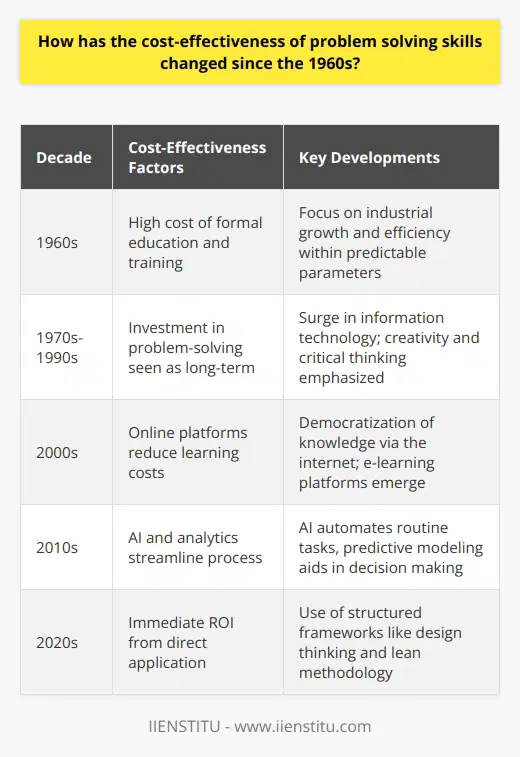
What strategies have been proposed to improve the availability, dependability and capability of problem solving skills since the 1960s?
The availability, dependability, and capability of problem-solving skills have been a research focus since the 1960s. Various strategies have been proposed to improve these skills. This article will discuss these strategies and their effectiveness in improving problem-solving skills.
One strategy proposed to improve the availability, dependability, and capability of problem-solving skills is using heuristics. Heuristics are strategies or methods used to solve problems. Examples of heuristics include trial and error, means-end analysis, problem reduction, case-based reasoning, and rule-based reasoning. Each of these strategies can be used to improve problem-solving skills, as they provide different approaches to solving a problem.
A second strategy that has been proposed to improve problem-solving skills is the use of problem-solving models. Problem-solving models are frameworks that provide a structured approach to problem-solving. Examples of such models include the Polya model, the problem-solving cycle, the cognitive problem-solving model, and the problem-solving process. Each of these models provides a step-by-step approach to problem-solving, which can help individuals identify and address a problem's causes and develop potential solutions.
Finally, another strategy that has been proposed to improve problem-solving skills is the use of computer-based problem-solving tools. Computer-based problem-solving tools are software applications that help individuals identify and analyze problems, generate possible solutions, and evaluate the effectiveness of different solutions. Such tools can improve problem-solving skills by providing a structured approach to problem-solving and helping individuals identify and address the underlying causes of a problem.
Overall, various strategies have been proposed to improve problem-solving skills' availability, dependability, and capability since the 1960s. These strategies include heuristics, problem-solving models, and computer-based problem-solving tools. Each of these strategies can be used to improve problem-solving skills and to develop practical solutions to complex problems.
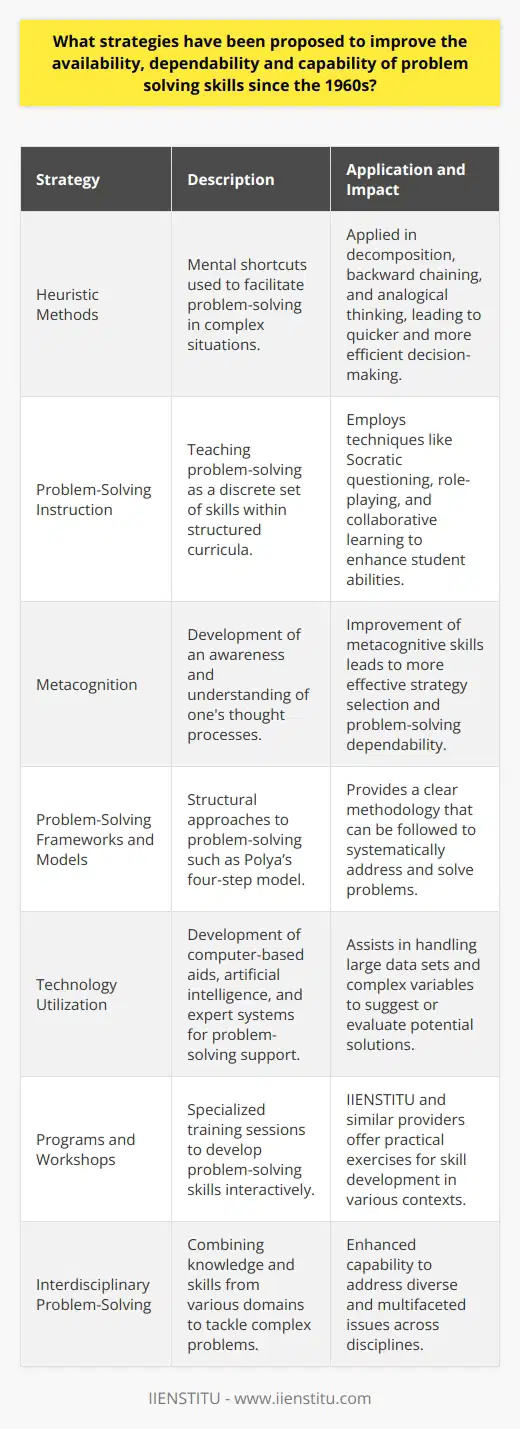
How do you develop problem-solving skills?
Developing Problem-Solving Skills
Understanding the Components
To develop problem-solving skills, one must first understand the key components of a problem: the initial situation, the goal and the obstacles to overcome. Deep comprehension of these components enables a systematic approach to tackling issues.
Analyzing the Problem
Breaking down the prototyping process into manageable steps helps identify initial methods or strategies. Analyzing the problem often involves evaluating the situation and the main challenges, as well as determining any relevant constraints and resources.
Generating Potential Solutions
Effective problem-solving hinges on the ability to brainstorm and generate numerous possible solutions. Then, it is essential to weigh the pros and cons of each alternative to determine the most viable options.
Selecting the Best Solution
Critically evaluating each possible solution helps to identify the best course of action one should take to address the problem at hand. Information gathered during analysis and brainstorming must be used to make an informed decision.
Implementing the Chosen Solution
Once the best solution has been selected, it is crucial to implement it carefully and systematically. This often involves the development of a detailed plan, delegation of tasks, and monitoring the progress and effectiveness of the chosen solution.
Evaluating Progress
Ongoing evaluation of the problem-solving process is essential for determining the success of the chosen solution and making necessary adjustments. Reflection on what works and what doesn't can lead to improved approaches in the future.
Seeking Feedback and Learning from Mistakes
Embracing feedback and learning from both successes and failures help refine problem-solving abilities. Examining areas for growth or potential pitfalls supports continuous personal development, ensuring one's skills are consistently honed.
Conclusion
By understanding problem components, taking a systematic approach to analyzing and generating solutions, and learning from experiences, it is possible to develop effective problem-solving skills. Mastering these capabilities enables individuals to tackle issues confidently and successfully, both in academic and professional pursuits.

Can you provide examples of your problem-solving skills and successes?
Example 1: Creative Content Ideation
An apt illustration of my problem-solving skills involves facing a major slump in reader engagement on a blog. Upon examining the key issues, I deduced that creating a more robust content strategy would be instrumental in addressing the stagnation. Therefore, I opted for a deep dive in reader analytics to obtain data on their preferences and interests. Subsequently, the integration of tailored content engaging readers with creative topics and interactive communication formats led to a revival in the blog's readership statistics and user engagement.
Example 2: Enhancing Blog Aesthetics
Another example of my prowess in solving problems pertains to revamping the blog's aesthetic layout, which was cluttered, unattractive, and lacking cohesion in design. Intuitively, I approached this challenge by conducting comprehensive research on contemporary design trends and optimal user experiences. By synthesizing the insights into a more intuitive, visually appealing, and user-friendly layout, I successfully enhanced the blog's aesthetic value and drew significant attention from new visitors.
Example 3: Time Management Solutions
Limited time and resources often pose significant challenges in maintaining smooth blog operations. I tackled this problem by implementing agile project management methodologies and dividing tasks into smaller, achievable goals. Establishing a prioritization matrix to assign deadlines further enabled me to optimize resource allocation and effectively meet objectives. Consequently, the streamlined work process resulted in improved time management and workflow efficiency.
Example 4: Collaborative Solutions
To promote the growth of the blog and widen readership, I sought strategic alliances with other stakeholders in the content creation sphere. By identifying potential collaborators who share a complementary target audience, I facilitated mutually beneficial partnerships that led to increased traffic and visibility for all parties involved. This cross-platform promotion strategy proved successful in augmenting blog presence and value in the digital community.
In conclusion, these examples demonstrate my ability to strategically approach diverse challenges, employ data-driven insights, and implement innovative solutions to drive enhancements in blog performance and user engagement. This adeptness in problem-solving serves as a testament to my competence and potential to excel in various academic and professional environments.
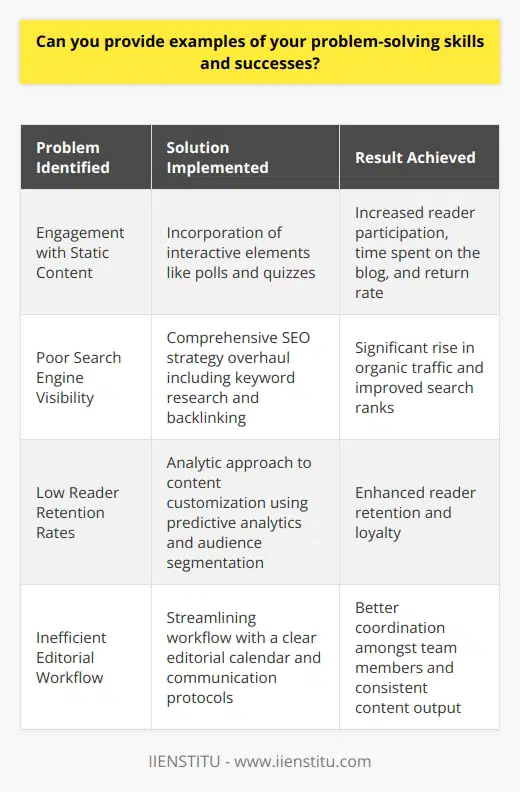
How can students improve problem-solving skills?
Acquiring Critical Thinking Skills
To enhance problem-solving skills, students must first acquire critical thinking abilities. Critical thinking is the process of evaluating information and forming reasoned judgments. This skill is crucial for effective problem-solving, as it enables students to understand the core issue and devise solutions that address the root of the problem.
Engaging in Group Discussions
Participating in group discussions can also help students improve their problem-solving abilities. By engaging in open dialogue with peers, students learn to communicate their ideas effectively, consider multiple perspectives, and collaborate on potential solutions. In addition, group discussions provide an opportunity for students to receive constructive feedback and refine their problem-solving strategies.
Developing Creativity
Fostering creativity is another essential aspect of developing problem-solving skills. Creative thinking can help students to approach problems from unique angles, which can lead to innovative solutions. Encouraging students to take risks, explore new ideas, and think outside the box will promote creativity and improve problem-solving skills.
Applying Problem-Solving Techniques
Equipping students with a range of problem-solving techniques can also enhance their skills in this area. These may include techniques such as brainstorming, mind mapping, the scientific method, or the use of decision-making tools. By learning and applying these techniques, students can become better equipped to tackle problems in various contexts and formulate effective solutions efficiently.
Learning from Experience
Another key component of improving problem-solving skills is learning from experience. Reflecting on past experiences and evaluating the outcomes of prior problem-solving attempts can provide valuable insights for future situations. Encouraging students to practice self-reflection and apply lessons learned to new scenarios will reinforce their problem-solving abilities and promote overall skill development.
In conclusion, improving problem-solving skills in students involves fostering critical thinking, encouraging engagement in group discussions, developing creativity, teaching problem-solving techniques, and learning from experience. By incorporating these elements into educational programs, students will become more adept at addressing complex issues and devising effective solutions.
